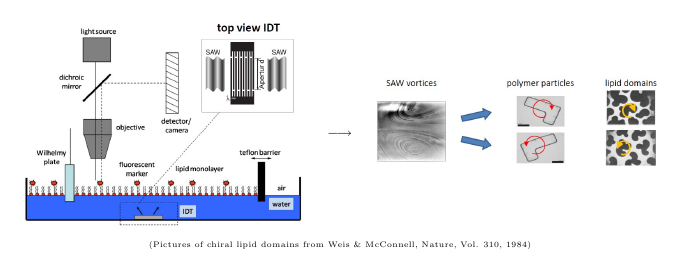You are here
Project Ronald Hoppe, Achim Wixforth, Malte Peter and Thomas Franke
Modeling, Simulation, and Validation of Transport at Interfaces in Lipid Membranes and Enantiomer Separation
This project is about the dynamics and formation of differently ordered phases in lipid layers and the separation of chiral objects (so-called enantiomers) in such layers. Under natural conditions, cell membranes, which are made up of a lipid bilayer, can be thought of as a binary fluid. The two phases arise as saturated and unsaturated lipids and they tend to organize in domains in the presence of cholesterol. In fact, the phase diagram for ternary systems exhibits different phases such as homogeneous liquid and gel phases as well as liquid–liquid and liquid–gel coexistence. These phase separation phenomena are not restricted to bilayer systems but also occur in lipid monolayers, which are easily accessible to experimental observations and control. Several different types of patterns have been observed, such as hexagonal structures and domains formed in the separation process that are chiral, i.e, domains which only differ by their handedness. The dynamics and the separation of the phases depends on various mechanisms such as temperature, viscosities, line tension, curvature and the presence of charged lipids. The first central aim of this project is to study systematically the impact of these mechanisms by providing appropriate mathematical models that will be validated through extensive numerical simulations and experimental measurements. The experimental setup allows to investigate the separation process in flat or almost flat monolayers as well as in curved lipid bilayers. Both setups will be considered in a unified modeling approach using the framework of Allen-Cahn/Cahn-Hilliard type equations. Numerical simulations will be done based on Discontinuous Galerkin Finite Element Methods. The separation of enantiomers by their chirality is an important process in many industries such as pharmaceutical, food, flavor, and fragrance. Most of the currently available separation techniques are costly and do not provide information about the dynamics of the separation process. However, it has recently been suggested to separate chiral objects by exposing them to specific flow fields created by piezoelectrically agitated surface acoustic waves (SAW). This technique, which already has been successfully used for generating flow fields in microfluidic biochips, is not only cost-effective but also has the potential for an extremely high time resolution of the dynamics of the separation process. The second central aim of this project is to model, simulate, and validate models of a setup, in which enantiomers are separated in lipid membranes by creating a flow field in the fluid below the membrane using SAW. This is supposed to be considered for several lithographically produced rigid chiral objects floating on the membrane as well as for elastic domains within the membrane which have been formed in the separation process. In particular, for enantiomer separation and the motion/deformation of elastic domains in the membrane we will use fictitious domain/Lagrange multiplier techniques and finite element immersed boundary methods.





